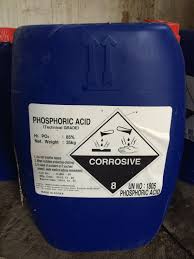crystalline, ≥99.999% trace metals basis
Synonym: Orthophosphoric acid
·
Linear
Formula H3PO4
·
Molecular
Weight 98.00
·
Beilstein
Registry Number 1921286
Properties
|
Related
Categories
|
|
|
vapor
density
|
3.4 (vs air)
|
|
vapor
pressure
|
2.2 mmHg ( 20 °C)
|
|
|
5 mmHg ( 25 °C)
|
|
InChI
Key
|
NBIIXXVUZAFLBC-UHFFFAOYSA-N
|
|
assay
|
≥99.999% trace metals basis
|
|
form
|
crystalline
|
|
bp
|
158 °C(lit.)
|
Phosphoric acid (also known as orthophosphoric acid or phosphoric(V)
acid) is a mineral (inorganic) acid having the chemical formula H3PO4. Orthophosphoric acid refers to phosphoric acid, which is the IUPAC name for this compound.
Detailed
description
The prefix ortho is
used to distinguish the acid from related phosphoric acids, called
polyphosphoric acids. Orthophosphoric acid is a non-toxic acid, which, when pure, is a solid at room temperature and pressure. The conjugate base of phosphoric acid
is the dihydrogen phosphate ion, H
2PO−
4, which in turn has a conjugate base of hydrogen phosphate, HPO2−
4, which has a conjugate base of phosphate, PO3−
4. Phosphates are nutritious for all forms of life.
2PO−
4, which in turn has a conjugate base of hydrogen phosphate, HPO2−
4, which has a conjugate base of phosphate, PO3−
4. Phosphates are nutritious for all forms of life.
In addition to being a chemical reagent, phosphoric
acid has a wide variety of uses, including as a rust inhibitor, food additive,
dental and orthop(a)edic etchant, electrolyte, flux, dispersing agent,
industrial etchant, fertilizer feedstock, and component of home cleaning
products. Phosphoric acids and
phosphates are also important in biology.
The most common source of phosphoric acid is an 85% aqueous solution; such solutions are
colourless, odourless, and non-volatile. The 85% solution is a syrupy liquid, but still pourable. Although phosphoric acid does
not meet the strict definition of a strong acid, the 85% solution is acidic
enough to be corrosive. Because of the
high percentage of phosphoric acid in this reagent, at least some of the
orthophosphoric acid is condensed into polyphosphoric acids.
For the sake of labeling and simplicity, the 85% represents H3PO4 as if it were all orthophosphoric
acid. Dilute aqueous solutions of phosphoric acid exist in the ortho- form.
Uses
The dominant use of phosphoric acid is for fertilizers, consuming
approximately 90% of production.[14]
|
Application
|
Demand (2006) in thousands of tons
|
Main phosphate derivatives
|
|
Soaps and detergents
|
1836
|
|
|
Food industry
|
309
|
|
|
164
|
||
|
68
|
||
|
Other applications
|
287
|
Food additive
Food-grade phosphoric acid (additive E338[15]) is used to acidify
foods and beverages such as various colas and jams. It
provides a tangy or sour taste. Various salts of phosphoric acid,
such as monocalcium phosphate,
are used as leavening agents.[14]
Rust removal
Phosphoric acid may be used to remove rust by direct
application to rusted iron, steel tools, or other surfaces. The phosphoric acid
changes the reddish-brown iron(III) oxide, Fe2O3 (rust) to ferric phosphate,
FePO4. An empirical formula for this reaction is:
2 H3PO4 + Fe2O3 → 2 FePO4 + 3 H2O
Liquid phosphoric acid may be used for dipping, but phosphoric
acid for rust removal is more often formulated as a gel. As a thick gel, it may be applied to sloping, vertical, or
even overhead surfaces. Different phosphoric acid gel formulations are sold as
"rust removers" or "rust killers". Multiple applications of
phosphoric acid may be required to remove all rust. Rust may also be removed
via phosphate conversion
coating. This process can leave a black phosphate coating
that provides moderate corrosion resistance (such protection is also provided
by the superficially similar Parkerizing and blued electrochemical conversion coating processes).
In medicine
Phosphoric acid is used in dentistry and orthodontics as an etching solution, to clean
and roughen the surfaces of teeth where dental appliances or fillings will be
placed. Phosphoric acid is also an ingredient in over-the-counter anti-nausea
medications that also contain high levels of sugar (glucose and fructose). This acid is also
used in many teeth whiteners to eliminate plaque that may be on the teeth
before application.
Other applications
Among many applications, phosphoric acid is used:
·
As a solution for anodizing
·
As a buffer agent in biology and chemistry; For
example, a buffer for high-performance
liquid chromatography.
·
As a chemical oxidizing agent for activated carbon production, as used
in the Wentworth Process.[16]
·
With distilled water (2–3 drops per gallon) as an
electrolyte in oxyhydrogen generators.
·
As a catalyst in the hydration of alkenes to produce
alcohols, predominantly ethanol.
·
In compound semiconductor processing,
phosphoric acid is a common wet etching agent: for example, in combination with
hydrogen peroxide and water it is used to etch InGaAs selective to InP.[17]
·
Heated in microfabrication to etch silicon nitride (Si3N4).
It is highly selective in etching Si3N4 instead of SiO2, silicon dioxide.[18]
·
As a cleaner by construction trades to remove
mineral deposits, cementitious smears, and hard water stains.
·
As a chelant in
some household cleaners aimed at similar cleaning tasks.
·
In hydroponics pH solutions to
lower the pH of nutrient solutions. While other types of acids can be used,
phosphorus is a nutrient used by plants, especially during flowering, making
phosphoric acid particularly desirable.
·
As a dispersing agent in detergents and leather
treatment.
·
As an additive to stabilize acidic aqueous solutions
within a wanted and specified pH range.
Packaging
25, 100 g in poly bottle
Packaged in poly bottles
PRICE
$2347.91/KG OR $1067.23/IB
For more information:
mobile: +2348039721941
contact person: emeaba uche
e-mail: emeabau@yahoo.com

No comments:
Post a Comment